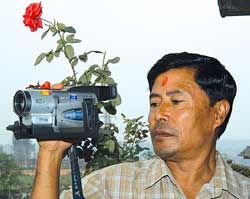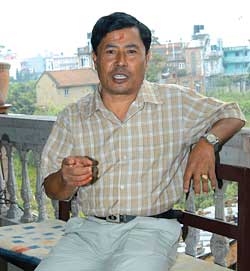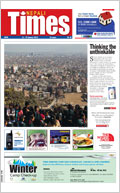 For someone who was wrongly accused of being a terrorist, who had to go through three months of excruciating mental torture in solitary confinement and who was then deported like a criminal, Purna Raj Bajracharya shows little anger towards his tormentors.
For someone who was wrongly accused of being a terrorist, who had to go through three months of excruciating mental torture in solitary confinement and who was then deported like a criminal, Purna Raj Bajracharya shows little anger towards his tormentors. But he adds: "If someone helps me, I'll sue the US government. If they want me to testify, I'll testify." Two years after returning to Nepal, Bajracharya now lives in quiet retirement in his house in Patan with his family. He told us he harbours no ill will towards Americans. "It's just like in Nepal, there are good people and bad people in America too," he says.
Bajracharya's ordeal (see story) began just as he was getting ready to head back to Nepal after spending six years in the United States. He had overstayed his visa to work in restaurants and sell flowers. He had saved up $37,000, which he sent home to take care of schooling for his four boys.
One month after planes hijacked by terrorists struck the World Trade Centre, Bajracharya decided to test his newly-acquired video camera (pictured, above on Thursday at his home in Patan) to shoot street scenes in the borough of Queens. Suddenly, a car pulled up, and two plainclothesmen called him: "Hey, come over here."
 Bajracharya recalls: "I could have run away, but I didn't. I hadn't done anything wrong." Then three more burly-looking men joined them and asked why he was taking pictures. "I told them, I didn't know, I was just a tourist," he says. He was taken into a nearby building and searched, his video cassette was played and they interrogated him for five hours. Finally they drove him to his apartment and searched it too.
Bajracharya recalls: "I could have run away, but I didn't. I hadn't done anything wrong." Then three more burly-looking men joined them and asked why he was taking pictures. "I told them, I didn't know, I was just a tourist," he says. He was taken into a nearby building and searched, his video cassette was played and they interrogated him for five hours. Finally they drove him to his apartment and searched it too. It was when they took him to jail, put him in shackles and threw him into a small cell that Bajracharya started getting worried. "Bekar ma phasiyo," Bajracharya recalls telling himself. But he was sure that since this was America, someone would realise the mistake and come to free him. But the solitary confinement lasted three months, the light in his cell couldn't be turned off. "I thought I was slowly going crazy," says Bajracharya, now 53. "The only thing that kept me going were memories of home and my family."
The ordeal had become just a distant memory when the FBI agent who arrested him, James P Wynne, who collaborated with legal aid activist Olivia Cassin, decided to publicise Bajracharya's story in the aftermath of the scandal over the ill treatment of Iraqi prisoners by US guards at the Abu Ghraib prison. New York Times immigration reporter Nina Bernstein got hold of the story and it was carried in the 30 June edition of the paper.
Suddenly, Purna Raj Bajracharya has to relive every moment of those three grueling months all over again.


